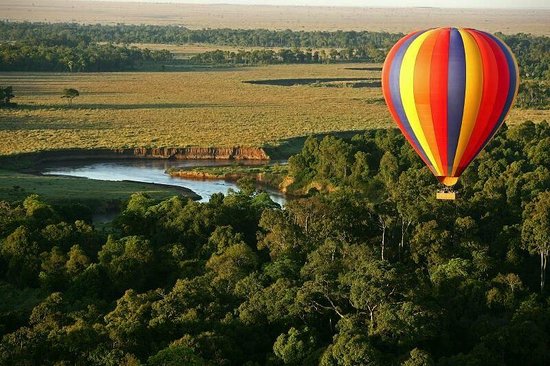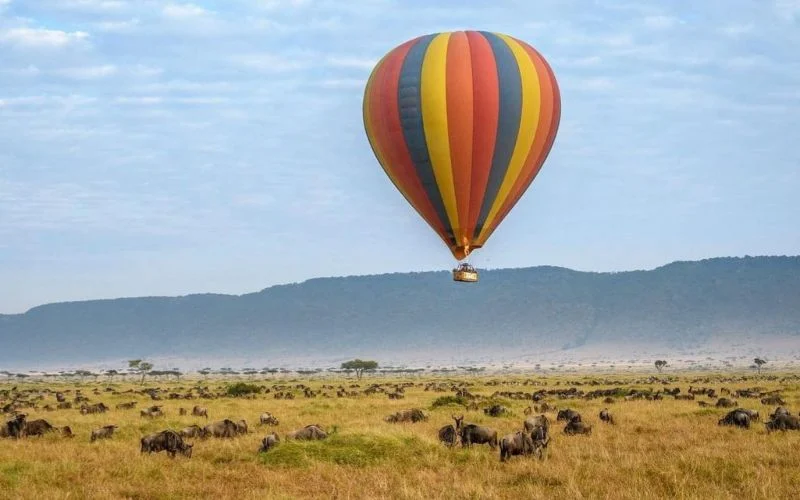Is a hot air balloon in Masai Mara worth it? The best kenya safari tour experience is soaring from the air over the Masai Mara. Below, there is an endlessly fascinating blend of rocky rivers, expansive savannahs, towering escarpments, and riverine forests. Hot-air balloon rides in the Masai Mara offer a unique perspective of the diverse species that lives below, all set against the backdrop of breathtaking sunrises. Nothing compares to it; the Kenya safari experience is amazing and the view is unmatched.

Nothing compares to the sense of freedom and excitement that comes from taking off high over the African plains. Sure, it may sound like a pain in the ass, but the benefits of going on this high-flying adventure far outweigh the inconvenience of setting your alarm clock for somewhere between 4 and 5 AM.
As your guide takes you to the balloon launch pad, you’ll start to feel the excitement building. The balloon crew will inflate your balloon and get everything ready for take-off while you sip hot your coffee or tea.
Your pilot will inform you briefly before launching the balloon after it has been filled and you have climbed into the basket underneath it. Your balloon will gradually ascend to the sky as the sun starts to rise in a breathtaking display of flaming reds and golds.
What to see
You will be able to witness the ‘Great Migration’ while flying over the African plains if you choose to travel to the Masai Mara between July and October. Nothing compares to the phenomenon of gazelles, zebras, and wildebeest herds migrating.
One of the greatest ways to understand the scope of what’s happening is to take a hot air balloon ride above the herds. The pilot will fly low when observing predators like lions pursuing their prey, seeing leopards sitting high in trees, and witnessing active hyena dens offering a fulfilling safari in kenya sights to observe.
The Cost of Hot Air Balloon Safaris
The cost of hot-air balloon rides is high, particularly in far-flung places like the Masai Mara. The cost of a hot air balloon ride starts at $450 USD per person. The short lifespan of balloons—just a few hours before they need to be replaced—is one of the causes of this. In order to ensure the safety of passengers, balloons are retired after about 850 flight hours and a new balloon must be bought. The amount of fuel and the number of staff to operate the hot air balloon is another factor that drives up the cost of hot air balloon trips.
A licensed balloon pilot and six other crew members make up each crew. To launch each hot air balloon, there are extra ten people work behind the scenes (per balloon). Furthermore, backup operations, recovery vehicles, and transfer vehicles are needed for every hot air balloon flight. The conservation fees also account for a significant amount of the hot air balloon flight fees.
- The cost of a balloon safari includes: The hot air balloon ride which lasts for around an hour
- Landing fees for conservation or national reserves
- Transfer from your safari camp or lodge
- Champagne-style bush breakfast
- Return to camp after breakfast
Planning a Hot air balloon safari in Mara
Most of hotels and camps in the Greater Mara region offers Masai Mara hot air balloon safari. A balloon safari is an extremely popular kenya safari activity that fills up quickly, it is advisable to make reservations in advance (especially during peak season). Please remember to pack a backpack to hold your camera, binoculars, and other personal belongings, as well as some warm clothes.
Bad weather
What would happen, then, if bad weather forced the cancellation of the hot-air balloon trip? Naturally, the hot air ballooning team prioritises safety, so if the weather isn’t ideal, your flight can be cancelled. If this happens, a later flight will be booked for you if at all possible. You will receive your money back if this is not an option.
The Great Migration in Mara
The adage “the grass is always greener on the other side” is all too familiar. It turns out that the grass is greener on the opposite side during the big migration. Over two million zebras, wildebeest, and other herbivores travel annually from the southern Serengeti to the Masai Mara’s verdant grasslands. The Great Migration is a famous safari must-see and is regarded as one of the seven wonders of the world.
The ‘great’ in ‘Great Migration’ might be a bit of an understatement, as 12,000 eland, 300,000 Grant’s and Thomson’s gazelles, 400,000 zebra, and 1.5 million wildebeest journey from the southern Serengeti to the Masai Mara. An famous natural phenomena, the migration occurs year-round and is influenced by weather, environmental conditions, and, of course, the animals themselves. To put it briefly, the world’s largest animal migration follows the rains. In pursuit of water and more fertile, mineral-rich grasses, the herds circle the Serengeti and Masai Mara ecosystems 800 kilometres in a clockwise direction. The animals travel the lush plains of the Masai Mara for several months, but they spend the most of their cycle in Tanzania’s Serengeti.
There are plenty of deadly predators waiting for the herds of gazelles, zebras, and wildebeest as they enter the Masai Mara. In addition to the danger posed by the large cats, the lemming-like herds must traverse the Mara River, where more than 3,000 crocodiles hide in the waters. The animals go when the rains stop and the food supply diminishes.
July through October are often the finest months to witness the Great Migration in the Masai Mara. Remember, however, that mother nature is in charge of herself. We will give you a very likely sketch of when those significant events of the Great Migration will occur, although it is clearly impossible to predict with certainty when the herds will cross a river. The weather can change suddenly, and early or late rainfall can cause a delayed or early migration pattern. The good news is that you may enjoy the abundance of wildlife in the Masai Mara throughout the year.

The busiest months in the Masai Mara are July through October, which are also the months most often cited as the ideal times of year to see the Great Migration. It’s safe to assume that throughout these months, you won’t have the herds to yourself. In the actual Masai Mara National Reserve, there will likely be more safari visitors, and lines may form during Kenya safari game drives. We suggest staying in one of the Masai Mara conservancies during this time for a more tranquil experience.
July
the herds depart the plains of the Serengeti in late July and early August in search of food and water. The crossings of the Mara River are most spectacular during this time.
August
By August, the majority of the migratory herds will have arrived in the Mara. A group of large cats who are eager to hunt meet them too hide in the bushes around the river.
September
In September, the grasslands are rather peaceful for the herds. Kenya safari game drives in the Masai Mara National Reserve are ideal during this time of year.
October
The relentless cycle of the great migration continues as the rains start to fall in October and the herds begin returning to the Serengeti in November.


